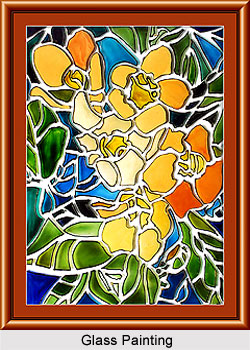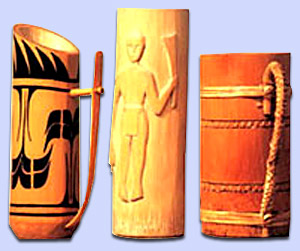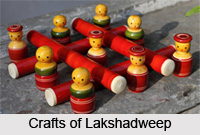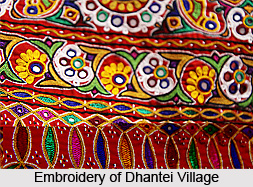 Glass painting in India flourished in the late 18th and early 19th century`s platforming search for identity by seeking a style, a profound reorientation towards a changed world of art and artistry! Yellow pages from history of art whisper that the Chinese artists learnt the art of glass painting from Europe, the symbol of cultural monarchy. The flourishing trade relations between British East India Company and China had introduced and cultivated this form of art to India. The works of the Chinese artists was hugely praised by the Indian rulers and were patronised by the contemporary monarchs at Mysore and Satara at that time.
Glass painting in India flourished in the late 18th and early 19th century`s platforming search for identity by seeking a style, a profound reorientation towards a changed world of art and artistry! Yellow pages from history of art whisper that the Chinese artists learnt the art of glass painting from Europe, the symbol of cultural monarchy. The flourishing trade relations between British East India Company and China had introduced and cultivated this form of art to India. The works of the Chinese artists was hugely praised by the Indian rulers and were patronised by the contemporary monarchs at Mysore and Satara at that time.
History of Glass Painting
History murmurs that the ongoing trend of glass painting first earned the crown of popularity during the rule of Panembahan Ratu II (1568-1646), the sixth sultan of Kraton Pakungwat, a long saga before the kingdom was segmented into Kasepuhan, Kanoman, and Kacirebonan palpable from the natural pigments consumed to produce the sunggingan that were admired back then. With time accelerating its forward march, natural pigments were substituted by synthetic pigments. The most popular brand is Kuda Terbang (Flying Horse), with turpentine used for thinner. Sugro helped popularize the use of paint and thinner; before then, painters used inkwells.
The glass paintings crafted by Sugro, the other painters in Trusmi, Cirebon are Christianised as classical paintings owing to the objects and motifs that have been handed down from the past- various calligraphy motifs, wayang motifs, kratonan (paintings of objects relating to the kraton), batik motifs, and so on.
Procedure of Glass Painting
 Ordinary painting concerns the painter simply jovial brushstrokes on the canvas while glass painting requires five stages. Producing a plek, a pattern or sketch on tracing paper of the object to be painted; the art is copied directly from an actual wayang .Then, the plek is shifted below a pane of clear glass, and the painter customises a rengreng, the contour or outline of the painting, directly on the glass from the plek below it. This rengreng or tracing is completed by the means of a rapidograph or a dip pen, as per the artistic expertise of the painter. After the completion of the same, the painter indulgently continues with the isen-isen, filling the interior space with dots.
Ordinary painting concerns the painter simply jovial brushstrokes on the canvas while glass painting requires five stages. Producing a plek, a pattern or sketch on tracing paper of the object to be painted; the art is copied directly from an actual wayang .Then, the plek is shifted below a pane of clear glass, and the painter customises a rengreng, the contour or outline of the painting, directly on the glass from the plek below it. This rengreng or tracing is completed by the means of a rapidograph or a dip pen, as per the artistic expertise of the painter. After the completion of the same, the painter indulgently continues with the isen-isen, filling the interior space with dots.
Next is the nyungging process, filling the object with colours, using a fine paint brush and finally is the natar process, enhancing the pictorial background. After each stage in this process there is also a time gap for the paints to dry. So what we end up considering is the reverse side of the painting, which is absolutely smooth and highlights no paint strokes embellishing the glass painting with a unique transcendence of art form. This technique is optimised as" negative style" because the painter produces the work from the back, while the beholders vision lies in the front; much like the traditional way to view a wayang kulit performance.
Features of Glass Painting
The glass painting in India developed as the local painters mellifluously painted their thematic crux, building castles on the arena of glass by depicting popular stories, epic themes, icons, portraits and icons on the glass paintings. This form of art climbed the stairs of popularity among the masses, absence of immaculate expense being the key word. The artists used to make pictures of the rulers and aristocrats including their mistresses and dancing girls. The artisans of each region had a distinct technique and creativity that differed from one another. The major centres of glass painting is located in Tamil Nadu, Karnataka, Andhra Pradesh, Kerala, Kutch, Gujarat, Rajasthan, Awadh, New Delhi, Bihar, West Bengal, Deccan, Satara, Hyderabad and Mumbai. The Thanjavur of Tamil Nadu is still carrying on the tradition of glass painting. The artisans create Thanjavur sacred icon paintings till date. Sometimes the glass paintings are embellished with gold leaf with the rich usage of bold and vibrant colours and semi precious stones that convey the creative magnificence of the deft artisans. Sometimes the painting of a deity is surrounded within frames. The glass paintings of Gujarat and South India stand out for their popular and folk art traditions that are displayed in the glass paintings.
The glass painting in India is categorised in two distinct ways one of them is traced as comparatively courtly while the other is folk painting. The contemporary styles of glass painting that are prevalent India have transcended the barriers of religious bigotries and mythological innuendos. Modern trends in glass paintings have witnessed the use of sand as base ground for the surrealistic forms in paintings flamed by the cult of post modern artists. Starting from Jamini Roy to Picasso, Van Gough, this entire painter`s work has been explored in abundance.
The traditional glass paintings were done with the glasses that were imported from Britain and Belgium. The drawing is characteristically bold and vigorous. The typical folk features may be mentioned with great lucidity of conception and with a symmetrical bias. The glass paintings are also embellished with gold leaf, small sequins and other shining particles that make the painting more appealing. Sometimes portions of the picture are mirrored with mercury. The language of the artistic glass painting in India is expressive, lively and intelligible. These paintings are used as the decorative items and enhance the look of showpieces, coasters, napkin holders, cutlery, wall hangings, etc. The glass paintings deserve to be placed as the antique articles for the intelligible designs and immense craftsmanship.






